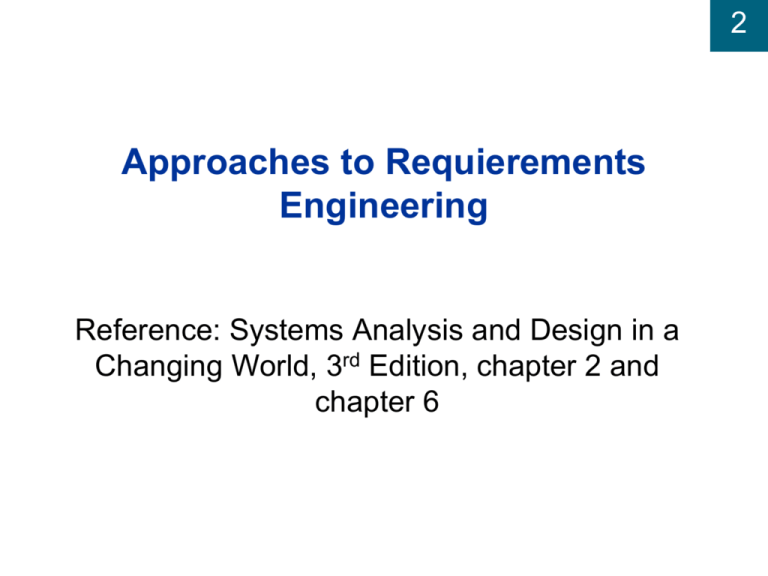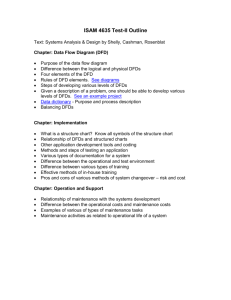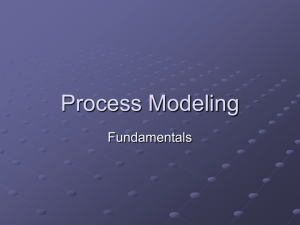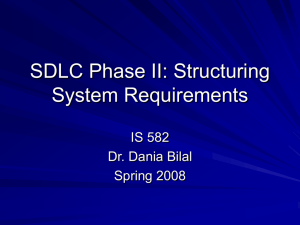Chapter 2
advertisement

2 Approaches to Requierements Engineering Reference: Systems Analysis and Design in a Changing World, 3rd Edition, chapter 2 and chapter 6 2 Overview Systems development life cycle (SDLC) Provides overall framework for managing system development process Two main approaches to SDLC Traditional approach: structured systems development and information engineering Object-oriented approach: object technologies requires different approach to analysis, design, and programming All projects use some variation of SDLC Systems Analysis and Design in a Changing World, 3rd Edition 2 Traditional and Object-Oriented Views of Activities Systems Analysis and Design in a Changing World, 3rd Edition 2 3 Requirements Models for the Traditional and OO Approaches Systems Analysis and Design in a Changing World, 3rd Edition 2 4 2 Structured Analysis Define what system needs to do (processing requirements) Define data system needs to store and use (data requirements) Define inputs and outputs Define how functions work together to accomplish tasks Data flow diagrams and entity relationship diagrams show results of structured analysis Systems Analysis and Design in a Changing World, 3rd Edition 5 2 Context Diagrams DFD that summarizes all processing activity Highest Shows level (most abstract) view of system system boundaries System scope is represented by a single process, external agents, and all data flows into and out of the system Systems Analysis and Design in a Changing World, 3rd Edition 6 Context Diagram for RMO Order-Entry Subsystem Systems Analysis and Design in a Changing World, 3rd Edition 2 7 2 Data Flow Diagrams Graphical system model that shows all main requirements for an IS in one diagram Inputs / outputs Processes Data storage Easy to read and understand with minimal training Systems Analysis and Design in a Changing World, 3rd Edition 8 2 DFD Fragment from the RMO Case Systems Analysis and Design in a Changing World, 3rd Edition 9 Data Flow Diagram (DFD) created using Structured Analysis Technique Systems Analysis and Design in a Changing World, 3rd Edition 2 10 2 Data Flow Diagram Symbols Systems Analysis and Design in a Changing World, 3rd Edition 11 Entity-Relationship Diagram (ERD) created using the Structured Analysis technique Systems Analysis and Design in a Changing World, 3rd Edition 2 12 Structured Analysis Leads to Structured Design and Structured Programming Systems Analysis and Design in a Changing World, 3rd Edition 2 13 2 Object-Oriented Approach Views information system as collection of interacting objects that work together to accomplish tasks Objects - things in computer system that can respond to messages No processes, programs, data entities, or files are defined – just objects Object-oriented analysis (OOA) Defines types of objects that do work of system Shows how objects interact with users to complete tasks Systems Analysis and Design in a Changing World, 3rd Edition 14 2 Object-Oriented Approach to Systems Systems Analysis and Design in a Changing World, 3rd Edition 15 2 Object-Oriented Approach (continued) Object-oriented design (OOD) Defines object types needed to communicate with people and devices in system Shows how objects interact to complete tasks Refines each type of object for implementation with specific language of environment Object-oriented programming (OOP) Writing statements in programming language to define what each type of object does Benefits of OOA include naturalness and reuse Systems Analysis and Design in a Changing World, 3rd Edition 16 Class Diagram Created During OO Analysis Systems Analysis and Design in a Changing World, 3rd Edition 2 17 2 Summary (continued) System development methodologies are based on traditional approach or object-oriented approach System development methodology provides guidelines to complete every activity in the SDLC Systems Analysis and Design in a Changing World, 3rd Edition 18 2 Summary Data flow diagrams (DFDs) used in combination with event table and entity-relationship diagram (ERD) to model system requirements IN TRADITIONAL APPROACH TO REQUIREMENS DFDs model system as set of processes, data flows, external agents, and data stores DFDs easy to read - graphically represent key features of system using small set of symbols Many types of DFDs: context diagrams, DFD fragments, subsystem DFDs, event-partitioned DFDs, and process decomposition DFDs Systems Analysis and Design in a Changing World, 3rd Edition 19







